About Android strings.xml - Several principles you should know

|
Don't try to reuse Do not reuse a string in different pages. 1. Suppose your login and registration pages both have a loading dialog box. Because both have loading interfaces, you decide to use the same string - R.string.loading. But you never know when you will use a different string, then you will need to create two new strings and modify the Java code. If you use two strings from the beginning, you only need to modify the strings.xml file. 2. You never know which languages your app will support. In one language - maybe you can use the same word in different contexts, but in another language different contexts may require different words. Note that in the English version of strings.xml, both R.string.download_file_yes and R.string.terms_of_use_yes are the same word - "Yes". But in Ukrainian version R.string.download_file_yes uses "Гаразд" and R.string.terms_of_use_yes uses "Так". Separation Strings on the same page are separated by prefixes and comments Add a page prefix to each string, helping you immediately identify which page a string belongs to. A clean strings.xml file helps you easily maintain and translate into different languages - page by page. Create a separate strings.xml file for each page If you want to create a strings.xml file for each page, you can name it like this: settings-strings.xml, profile-strings.xml. But an app usually has 10 to 20 pages. So there will be 10 to 20 strings.xml files in each language directory, which I think brings confusion. Format Use Resources#getString(int id, Object… formatArgs) to format strings Never use the + sign to concatenate strings, because different languages have different word orders. The correct way is to use Resources#getString(int id, Object… formatArgs). plural Use Resources#getQuantityString (int id, int quantity) to handle plural numbers Never resolve pluralization issues in Java code, because the grammatical rules for pluralization are different in different languages. The correct way is to use Resources#getQuantityString(int id, int quantity). Note: For more information about the getQuantityString method, see: Android Quantity Strings getQuantityString method value problem Word highlighting Use html text to highlight static words If you want to change color of some words in TextView - ForegroundColorSpan is not always the best choice, because its highlighting is done by index and it is not safe in multi-language. Use html's font color tag in strings.xml file. Suppose you have a text that says “Discover and play games.” You want the words “Discover” and “play” to appear in blue. |
>>: The fourth session of the Aiti Tribe Technical Clinic
Recommend
What is a clear process for setting up a Toutiao account?
The Bytedance advertising platform, also known as...
Are more and more people unsubscribing? You lack such a push data analysis method
Message push is the best channel for APP operatio...
New User Activation from the Aha Moment
In 2008, when you were staying in your dormitory ...
Global Handwashing Day | How did humans discover that handwashing is so useful?
According to the United Nations, more than 500,00...
Mount Everest has grown taller? Uncovering the secrets behind the river's invasion
Author: Duan Yuechu and Huang Yanhong On our plan...
Tang Jialu: 74-year-old ancient technology enthusiast restores historical "artifacts"
The book "Heavenly Creations" written b...
Attention! Orange warning for high temperature + yellow warning for heavy rain! These provinces and cities should beware of secondary disasters
Central Meteorological Observatory June 18, 06:00...
The evolution of web-based "application jump" technology
Due to the convenience of web communication, almo...
8 bad cooking habits are ruining your family’s health, correct them as soon as possible!
For some food connoisseurs, cooking by themselves...
The three Internet marketing crazes I experienced!
As someone who makes a living from management, in...
Top physicists will discuss the future of quantum at the birthplace of quantum mechanics
2025 was declared the "International Year of...
Are you a hair removal person or a comfort person?
The summer clothes that had been lying around for...
The mysterious "lone ranger" on the top of the snow-capped mountains frequently appears in the Qilian Mountains
On January 3, the Dongdahe Nature Reserve of the ...
"I always thought it was influenza A!" A woman had a fever for 2 weeks and was diagnosed with acute leukemia! These symptoms should not be taken lightly
"I always thought I had influenza A. Fortuna...









